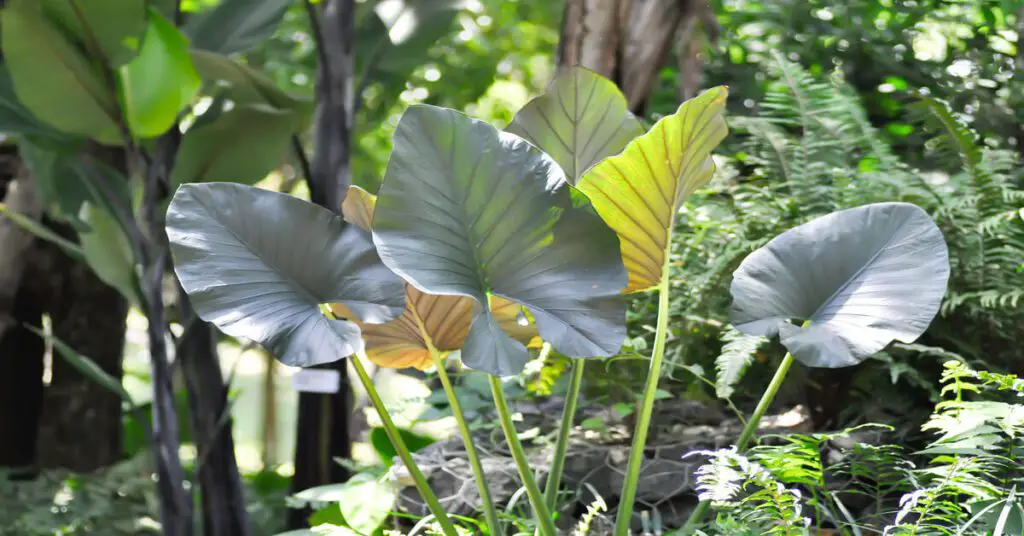The popularity of owning an Elephant Ear Plant or one of the Alocasia varieties is growing among gardeners. People also know it as Elephant Ear due to the shape of its leaves. Many regard it as one of the finest tropical plants for decorating your house or apartment.
Its striking look also makes it ideal for office space, where its ambiance and lovely foliage will help brighten the environment.
Because there are so many kinds of Alocasia, deciding which one to use for an interior garden or just for decoration might be challenging.
Pair your Alocasia with a stylish planter like this decorative indoor planter set to enhance its visual appeal.
So, in this article, a variety of Alocasia species and their characteristics have been listed below to assist you in choosing the best one for whatever purpose you desire.
For tips on starting a thriving garden in North Carolina, check out our guide on The Ultimate Guide to Year-Round Backyard Vegetable Gardening in North Carolina.
To explore more about Alocasia plants and their unique characteristics, visit this NC State University backed database Alocasia Plant Page.
21 Varieties of Alocasia
Alocasia Dragon scale
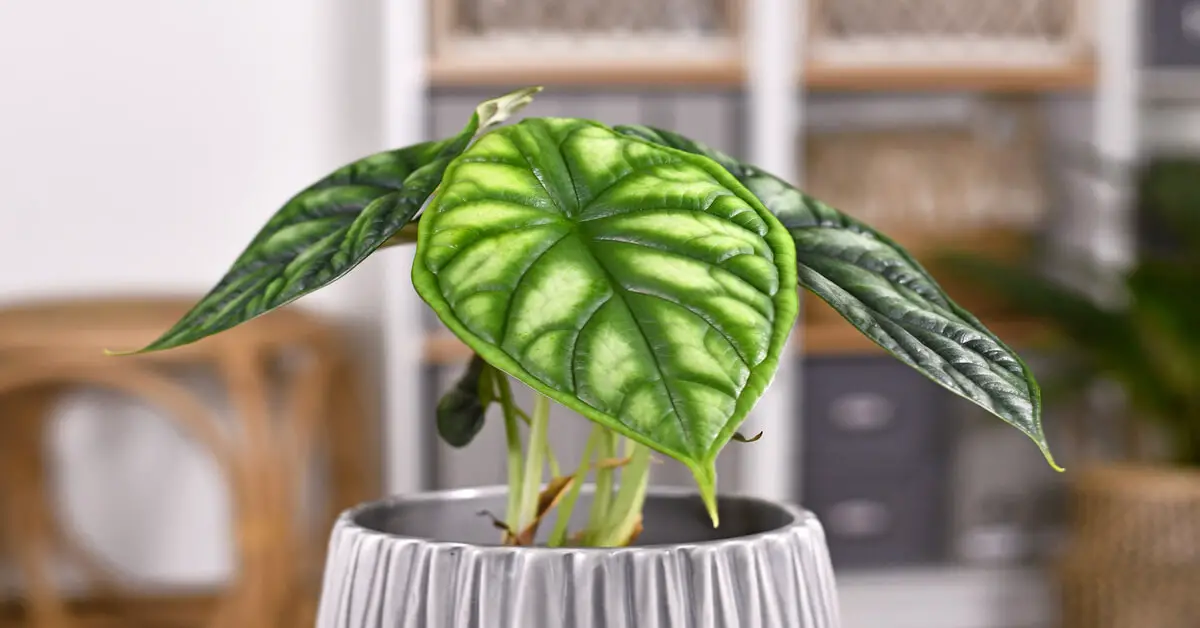
Formally known as Alocasia Baganda ‘dragon scale’, Alocasia dragon scale has a veined structure and stiff, flexible, silvery-green leaves that are deeper in the middle and lighter on the margins. With maturity, the plant’s coloring becomes more intense.
It favors humidity levels of 60-80%, temperatures of 55-80°F (13-27°C), and strong indirect sun or dappled shade.
The plant has an average sensitivity to pests and disease and requires relatively little fertilizer.
For a unique hybrid variety, consider exploring the Alocasia × Mortfontanensis, which combines traits of several Alocasia species.
If you’re growing Alocasia Dragon Scale indoors or in small spaces, you might find our guide on Container Gardening for Vegetables helpful for understanding soil and lighting requirements.
Alocasia Micholitziana Frydek
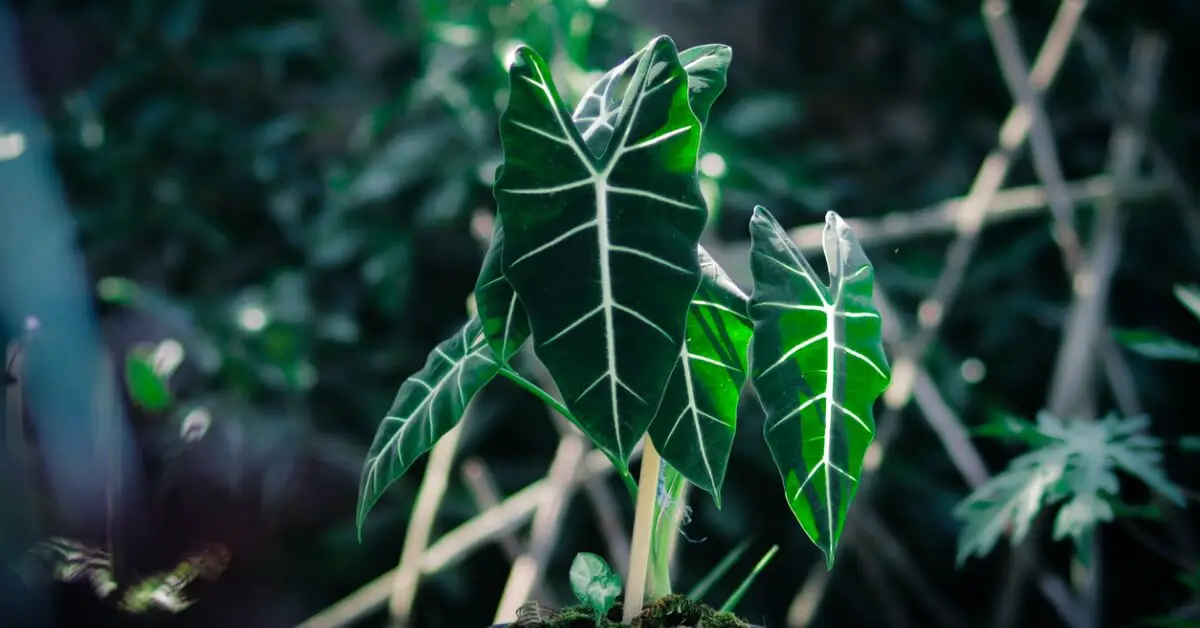
This variety of Alocasia Frydek is prized for its magnificently big arrow-shaped leaves with prominent white veins. It is also known as the Green Velvet Plant and grows more quickly in intense light. It may reach a height of 3 feet, with leaves that can stretch to 18 inches (45 cm). Additionally, the leaf edges vigorously or slightly undulate.
Alocasia micholitziana ‘Frydek’ requires a minimum temperature of 60°F (16°C).
Alocasia Baginda Silver Dragon
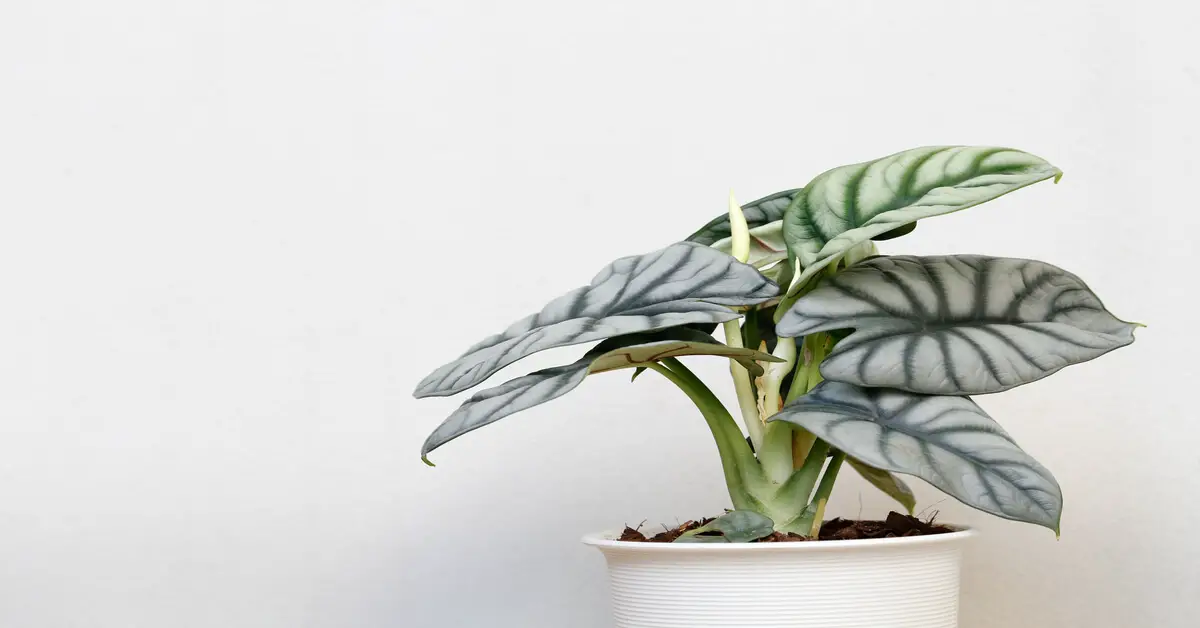
This variant of Alocasia also goes by the name Elephant Ear Silver Dragon. It has thick leaves with a deep green venation and a tint ranging from silver to light green. The leaf measures around 15 cm in length and 5 to 8 cm in breadth at maturity.
It can thrive at temperatures between 55 and 80 degrees Fahrenheit (12°C to 26°C) and requires abundant, indirect light and rich soil to reach a little above 1 meter height. Furthermore, healthy development requires a humidity level of at least 60%.
Alocasia Wentii
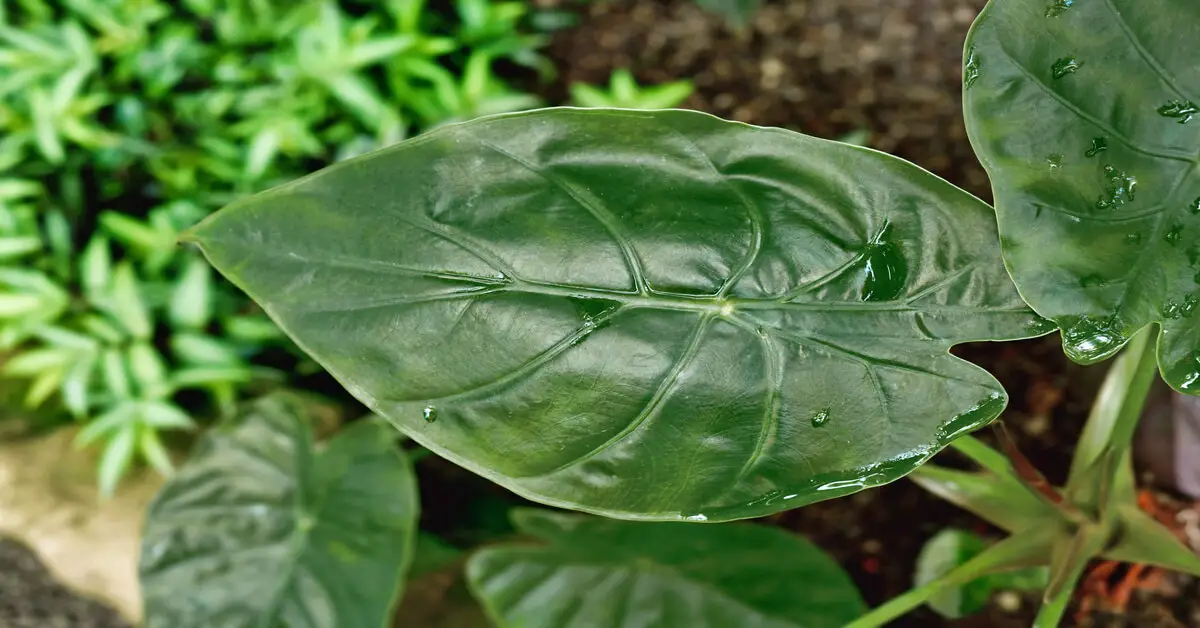
The glossy, heart-shaped leaves of the Alocasia Wentii are green or purple in color. Australia and Asia have widespread occurrences of it, but its first discovery was in New Guinea. It may grow up to 6-8 feet tall, but when cultivated in pots or treated as a houseplant, it often only reaches 3–4 feet.
This plant requires a minimum humidity of 60% humidity and an ideal temperature range of between 59°F and 86°F. Although its stem may be resistant, the plant itself is not frost-tolerant. Therefore, it cannot survive temperatures below 7°C.
Alocasia Macrorrhiza Variegata
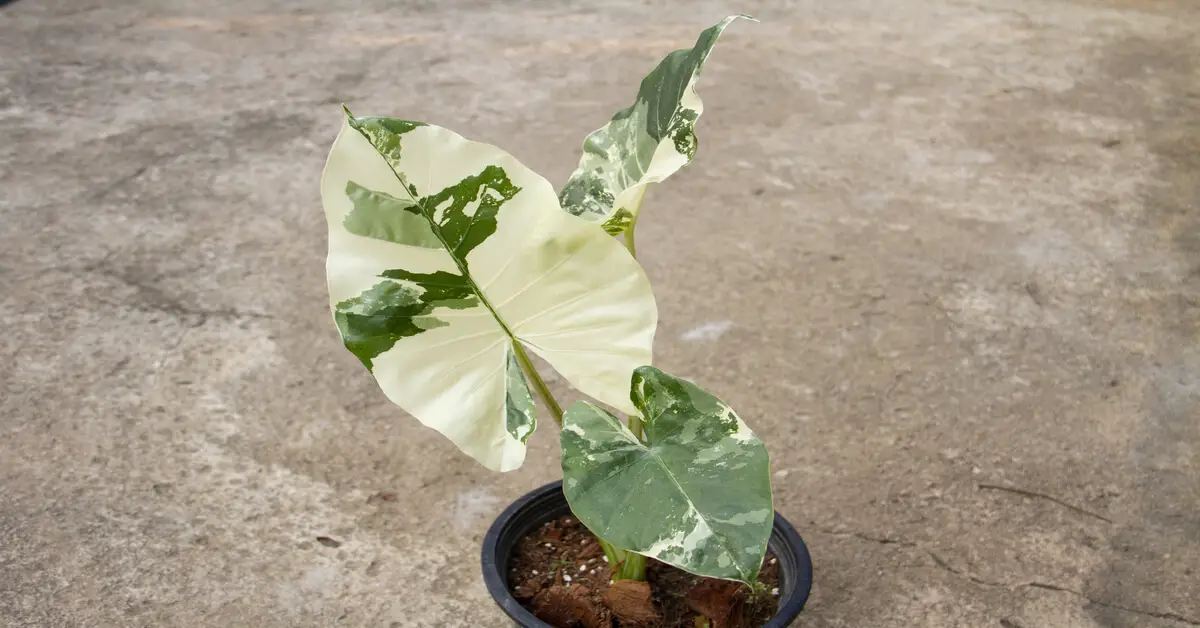
This Alocasia type typically reaches a height of 12 to 15 feet and a spread of 4 to 6 feet. The leaves are up to 3 feet long and 3 feet wide, arrow-shaped to shield-like, simple, with slightly wavy edges and pronounced veins, and widely variegated in green, cream, and white.
It thrives in loamy soil that is rich, quick to drain, and mildly acidic to neutral. Additionally, it needs a temperature range of 18 to 27 °C (65 to 80 °F).
If you love the dramatic foliage of Alocasia Macrorrhiza, you might also be interested in the Alocasia Calidora, a variety known for its stunning large leaves.
Alocasia Odora Variegata
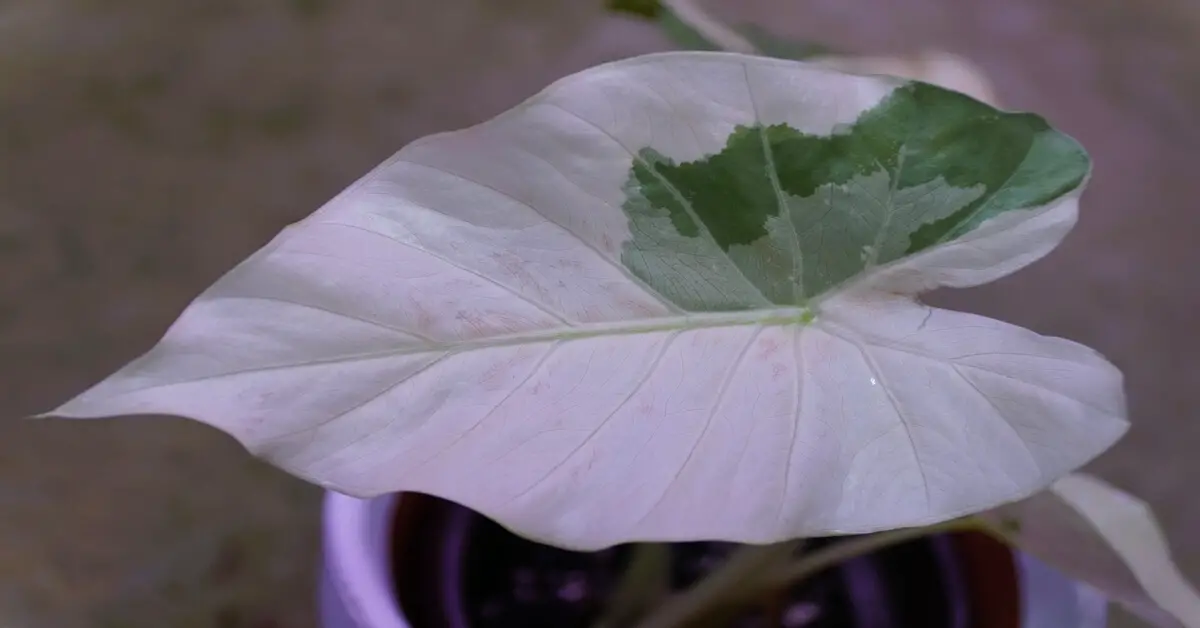
A Variegated Alocasia Odora has long, broad, heart-shaped leaves. It also has white spots on its smooth, green surface, which vary across each leaf. The plant does best in mild summer weather and has a neutral pH. When fully grown, it can reach heights of 2 to 8 feet and a width of 3 to 4 feet.
Alocasia Black Velvet
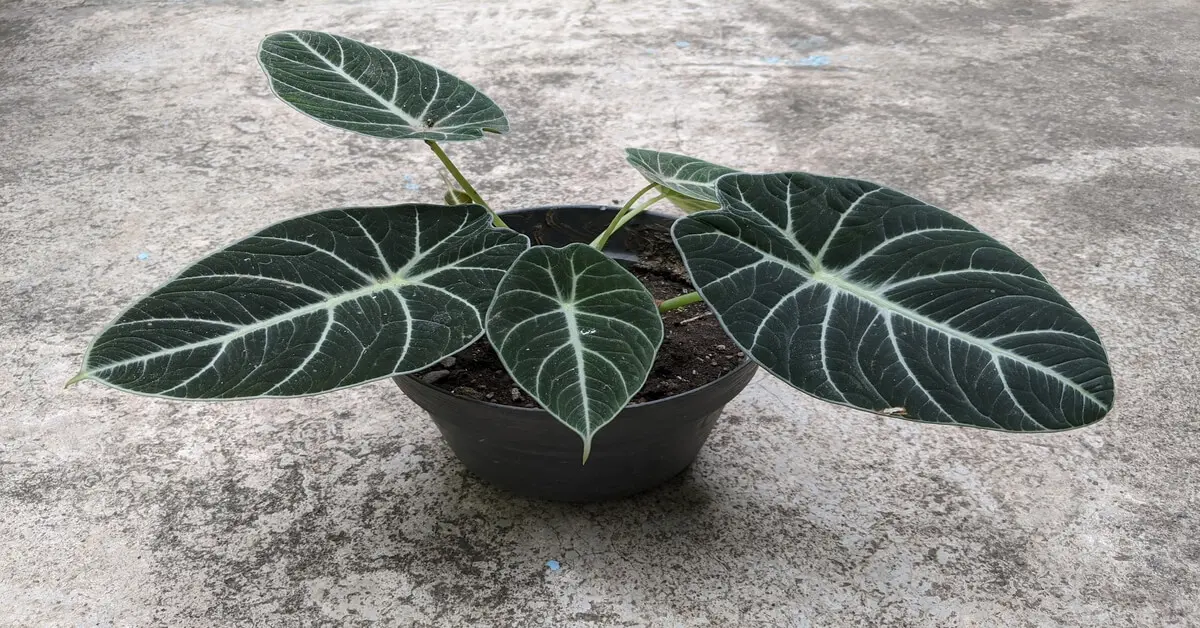
Black Velvet differs from many other Alocasia plants because it has a spherical, nearly heart-shaped leaf. The leaf’s hue is dark, almost black-green, and has a white vein.
It thrives best in loamy or sandy soil. It needs temperatures between 55 and 85 degrees and humidity between 45 and 70%. When fully grown, most plant samples are a little taller than 20 inches.
Alocasia Heterophylla Dragon’s Breath
Alocasia ‘Dragon’s Breath’ has elongated leaves, silver-hued and corrugated in texture. It blooms in bright, indirect light and watering, and as it ages, it can reach heights up to 24 inches. Dragon’s Breath flourishes best in high humidity and temperatures above 60 degrees, or it goes into dormancy.
Alocasia Cuprea Green & Red Secret
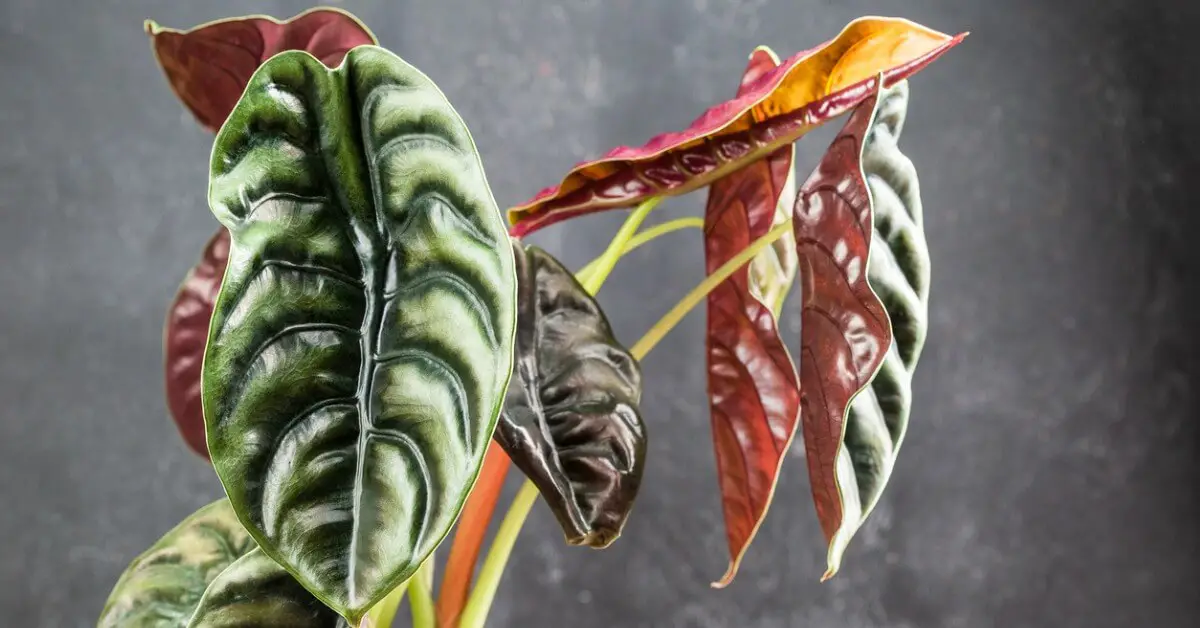
This strain is evergreen and perennial and stays fresh and all year long. It booms in extreme humidity and attains a maximum height of one foot when mature.
The leaves, which are big, oval, and metallic in appearance and range in color from dark green to red, make it famous for cultivation. The undersides of these leaves have a striking purple hue mark.
Alocasia Azlanii
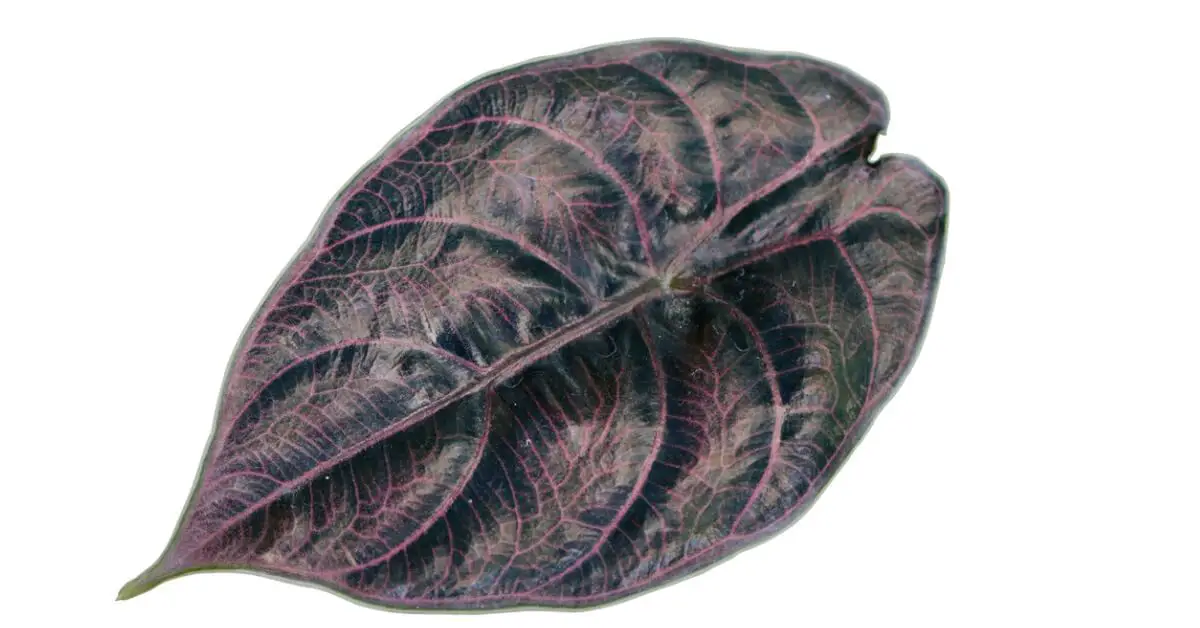
Alocasia Azlanii, often known as Red Mambo, has stunning leaves that are a metallic purple color with a pink undertone that highlights the veins. It originated in South Asian rainforests and certain parts of Australia.
Like most Alocasia, it strives in bright, indirect light. Also, it prefers greater humidity levels (at least 60%) and temperatures between 65 and 75 °F (18 and 24 °C). Additionally, it can grow as tall as 2 feet and has leaves no bigger than 8 inches.
Alocasia Melo
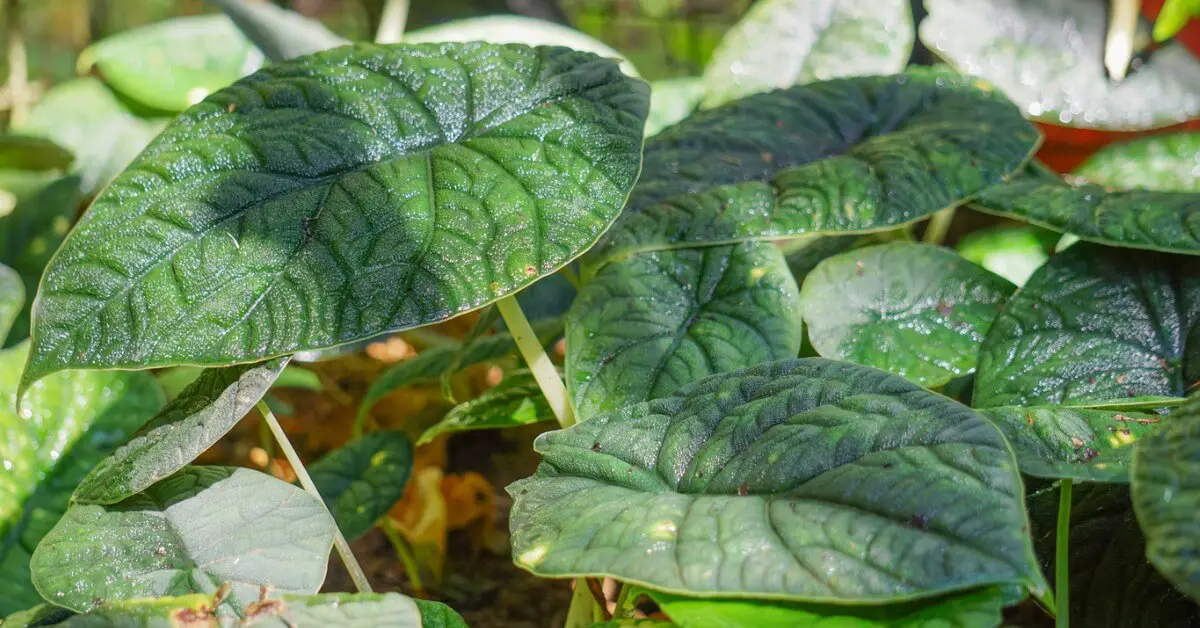
Melo is a species of Alocasia native to Sabah state in Malaysia. Unlike other varieties, it grows on ultramafic soils, that is, soil with low silica content.
It has thick-textured and large-sized greenish-blue leaves. The leaves range between 30-50 cm long and 25 cm wide. It also bears off-white colored leaves that appear in clusters of three.
In its natural habitat, it can reach a height of 23 inches. However, when grown indoors, it gets just 15 inches long.
Alocasia Amazonica Bambino
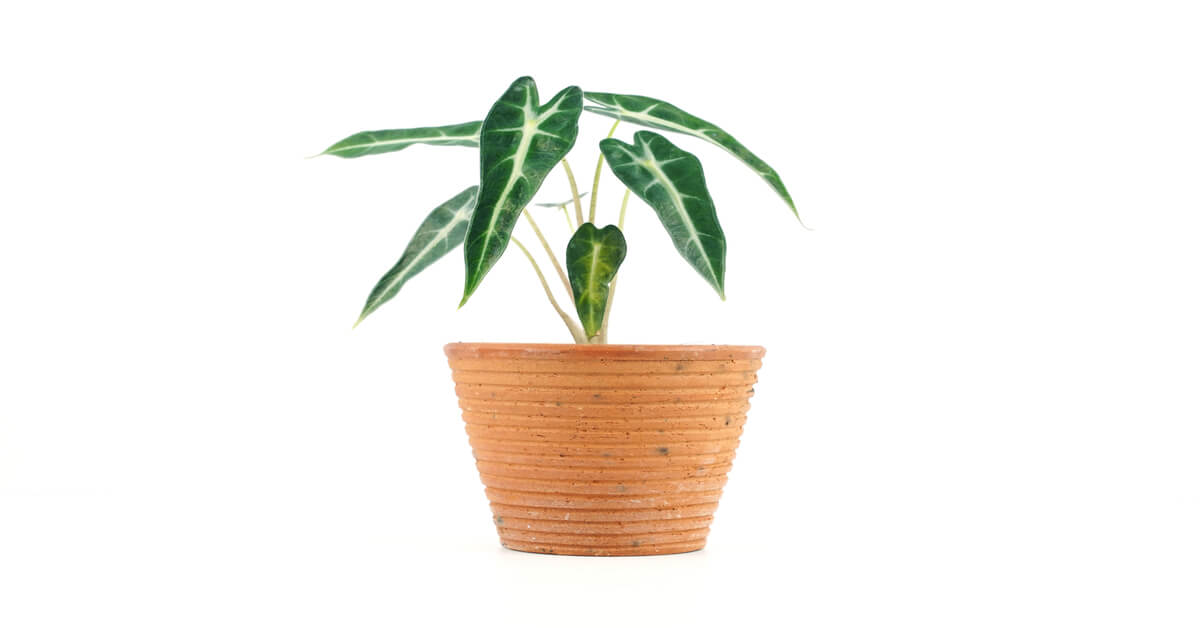
The Alocasia Amazonica Bambino, which is native to Southeast Asia, has long, arrowhead-shaped leaves. The veins of the leaves are white, while its undersides are burgundy. Also, the leaves can spread to cover an area of 15 to 18 cm long and 5 cm wide.
Because it grows to a height of roughly 12 inches when planted indoors, Alocasia Amazonica ‘Bambino’ is often known as the dwarf cultivar of Alocasia.
It blooms best in temperatures ranging from 64 to 72 degrees Fahrenheit, with a humidity of 70%.
Alocasia Zebrina

Alocasia zebrina is a gorgeous tropical evergreen perennial houseplant with stems that have zebra-like patterns and huge glossy green arrowhead leaves. This plant, also known as Alocasia zebrina Tiger or Alocasia Leopard, has long, spotted stalks that arch in odd patterns.
It may grow as tall as 2.9m(10ft) but typically only reaches 1.8 m. The leaves have a leathery feel and multiple cataphylls, yielding orange-colored fruits.
Alocasia Amazonica Polly
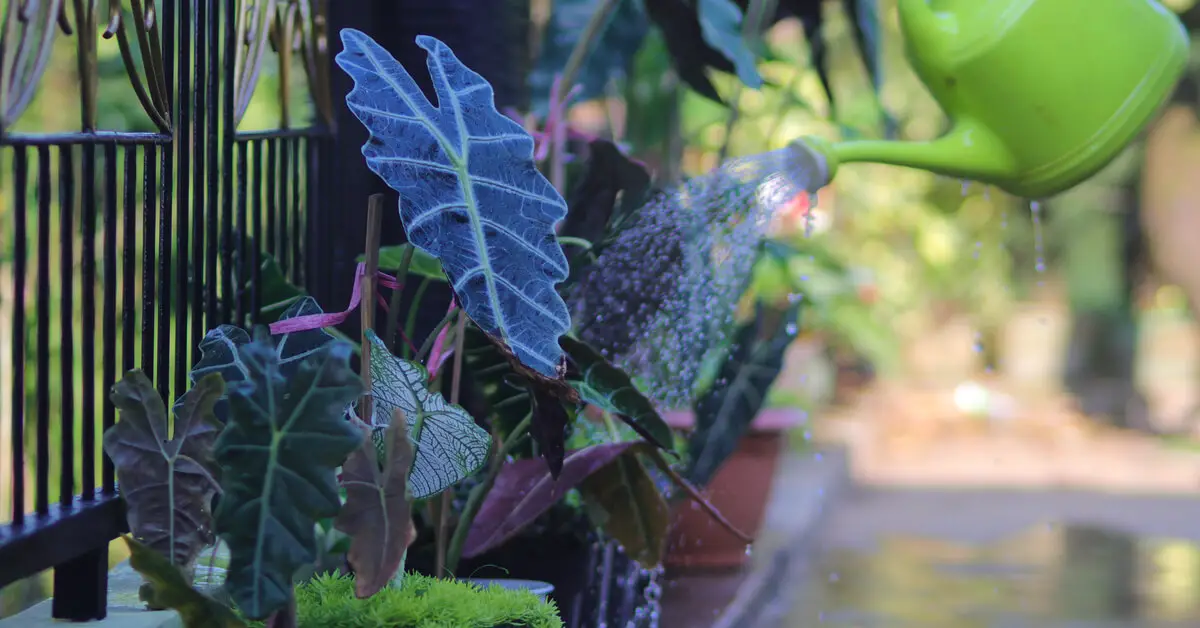
The Amazonica Polly is native to Southeast Asia, Southern China, and the Pacific Islands. It has lengthy solitary stems with big, arrowhead-shaped waxy leaves emerging from them. The underside of the leaves has a deep purple color with silver veining.
It can reach one to two feet with a spread about the same size.
For optimal growth, it needs partial sun exposure and loamy soil that has a neutral or slightly acidic pH.
Alocasia Macrorrhizza Stingray
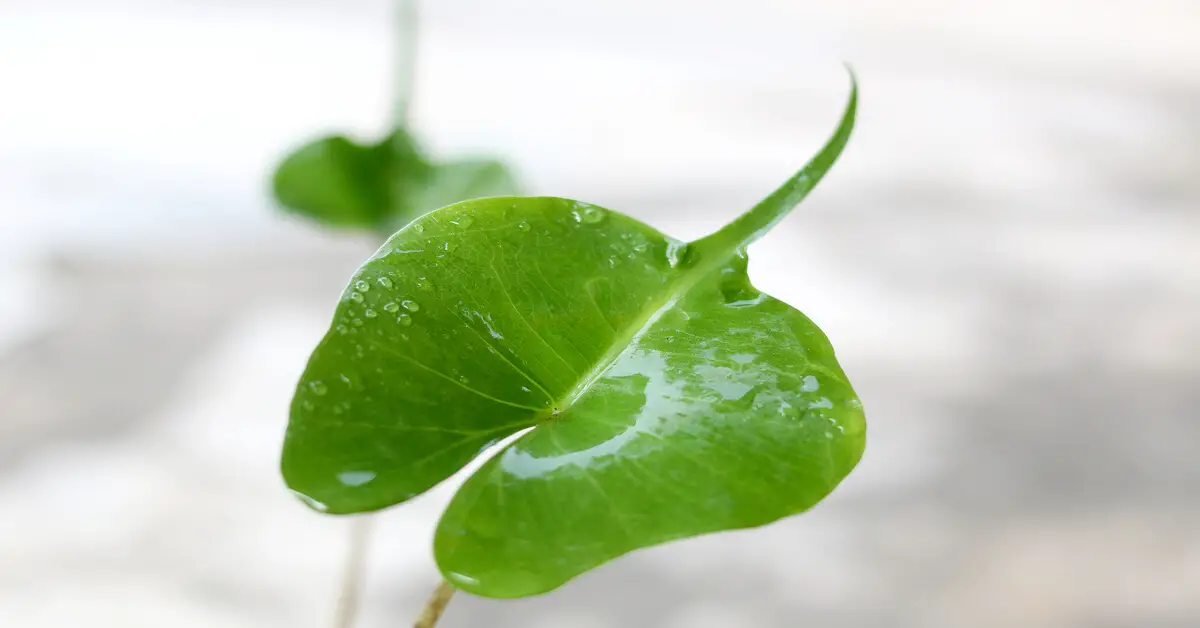
The name of this Alocasia arose from stingray dues to the extent to which its leaves mimic the aquatic mammal. The leaves of the Alocasia Macrorrhiza ‘Stingray’ houseplant point upward and outward, highlighting the surface’s ribbed, leathery, emerald-green color.
In warm climates, it may grow up to 5 feet tall outside. However, this growth potential significantly reduces when it is grown indoors.
This plant thrives in a temperature range of 18 °C (64.4 °F) to 22 °C (71.6 °F) and soil with a pH between 5.5 and 6.5, which is somewhat acidic.
Alocasia Chantrieri
This Alocasia hybrid is an uncommon and exceptional cross between the severely endangered Alocasia Sanderiana and Alocasia Metallica. It has gorgeously dark and nearly black glossy leaves with strong veining and rich maroon undersides.
It is best grown under strong indirect sun exposure and brief periods of partly direct sunlight, a chunky, well-draining soil mixture, moderate to high temperatures, and greater humidity. And like every other Alocasia plant, it should be grown out of the reach of pets as it is dangerous to them.
Alocasia Lauterbachiana Purple Sword
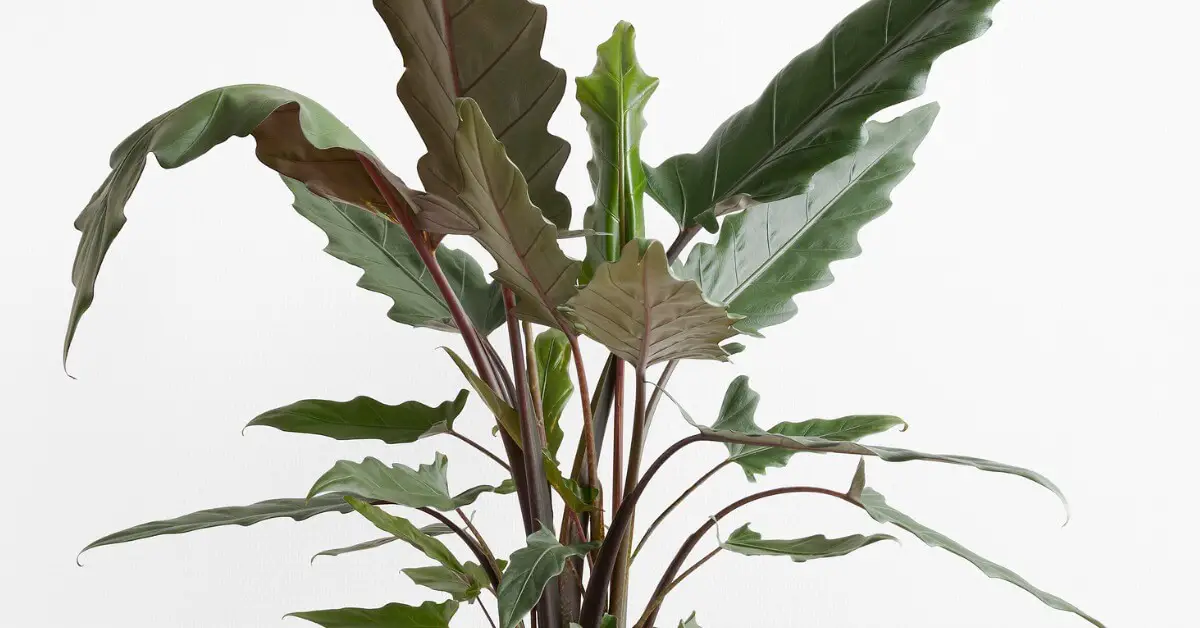
It also goes by the name Alocasia lauterbachiana. It has stems and leaves that are both dark purple and sword-shaped. It stands on tall, purple-to-brown petioles with scalloped edges and crimson undersides.
Its leaves may reach a maximum length of 2 feet and a maximum width of 2 inches. The plant may grow as high as four feet in the wild but is limited to a height of 1 to 3 feet when grown indoors for decorative purposes.
One other property of this lineage of Alocasia is that it produces tiny green or purple blooms that resemble the conventional Anthurium structure and have a finger-like spadix that emerges from a clasping spathe.
Alocasia Longiloba
This plant’s arrowhead-shaped, alternating, stalked leaves measure up to 3 feet long and one foot wide. Additionally, its leaves are dark green above and pale green or purple underneath with veins occasionally.
Longilobas possess stalks of chocolate brown color that are typically speckled. Its flowers sprout on a long stalk and contain a green to white spathe.
This plant may grow 2,000 meters above sea level in swamp woods, bamboo thickets, cliffs, limestone, regrowth, on exposed ridges and ravines, and rivers. When fully matured, it can attain a height of 5 feet and a spread of 2 feet.
Alocasia Puncakborneensis
This species of Alocasia is native to Borneo. It is an Alocasia type that grows tall, reaching a height of around 6 feet, and has leaves that can be up to 2.5 feet long.
Its best yield is obtained when grown in uniformly wet soil with good drainage and is slightly acidic with a pH between 5.5 and 6.5. Other growth requirements are bright and indirect light and glossy green foliage. The ideal temperature range is between 18 °C (64.4 °F) and 22 °C (71.6 °F), and it only grows well in high humidity.
Alocasia Reversa

Native to hills areas around Kuching in Malaysia, it derives its unique name from the fact that its color is deeper on and close to the veins than the usual Alocasia.
Alocasia Reversa quickly grows once its roots are set in warm weather. High humidity and well-drained loamy soil achieve rapid new development, with the ideal temperature range being between 60 and 85 Celsius.
They expand horizontally but seldom get taller than 19 inches when cultivated indoors.
Alocasia Sanderiana
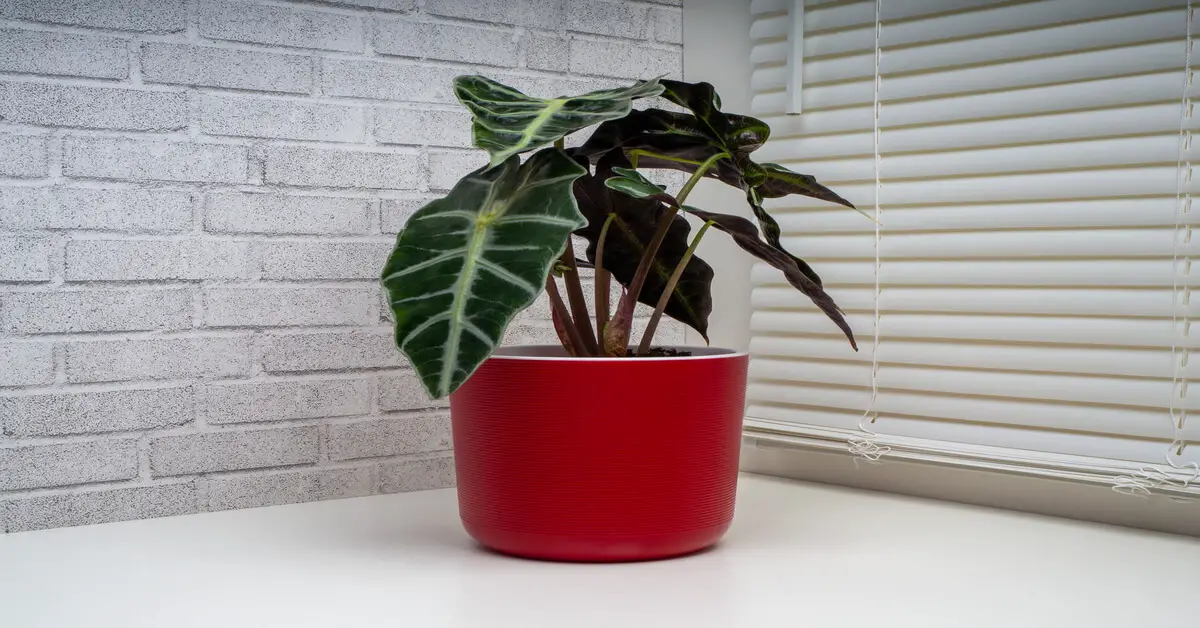
Alocasia Sanderiana is also known as the kris plant because its leaf edges resemble the wavy blade of the Kalis sword (also known as kris or keris).
It has deep, glossy, dark green to blackish-green leaves erected with big white to yellowish veins and borders. The leaves are 12-16 in (30-40 cm) long and 6-8 in (15-20 cm) broad and are either single or few. Furthermore, it has an underside that is generally (but not always) crimson to purple and can only reach a maximum size of 2 feet (60 cm) in height.
Fans of the striking Alocasia Sanderiana may also enjoy the Alocasia Sarawakensis ‘Yucatan Princess’, prized for its glossy foliage and bold appearance.
Looking to learn more about specific Alocasia varieties? Check out detailed guides on Alocasia and individual species like the Alocasia Calidora or the Alocasia Sarawakensis ‘Yucatan Princess’ for inspiration.

